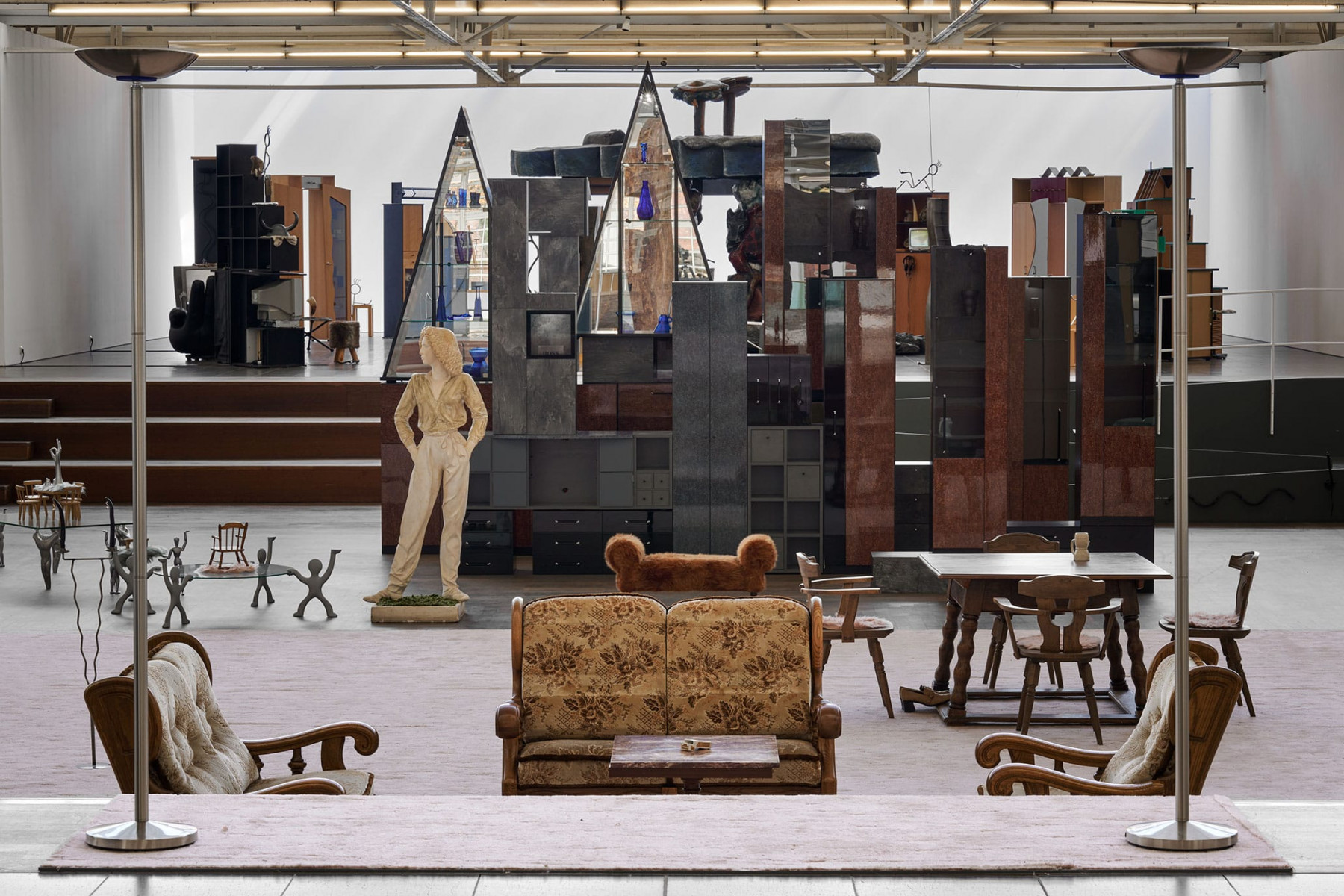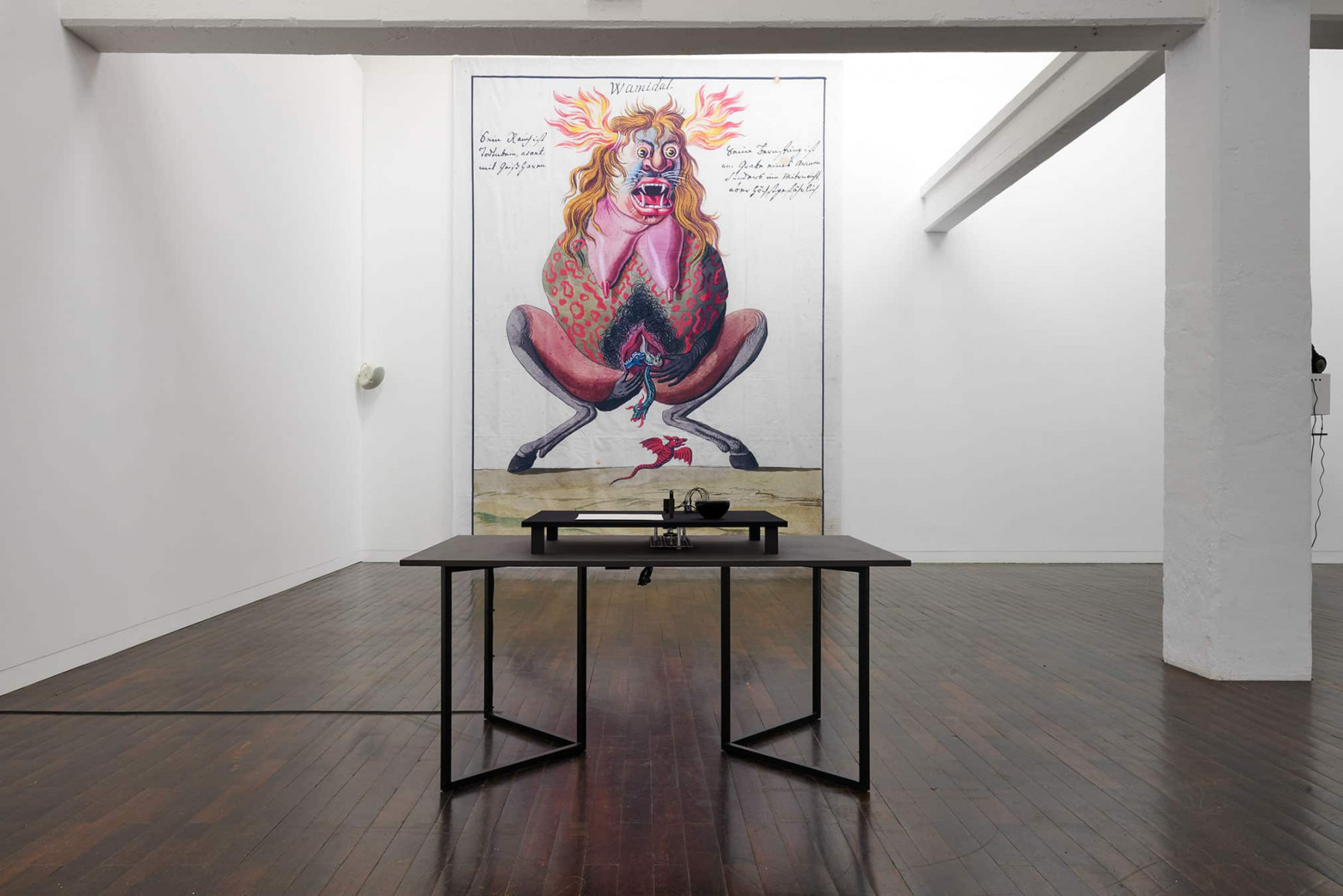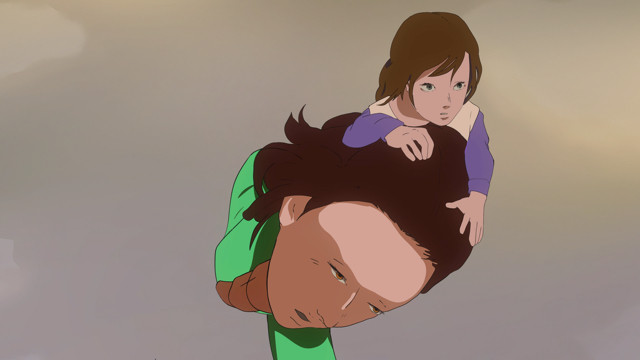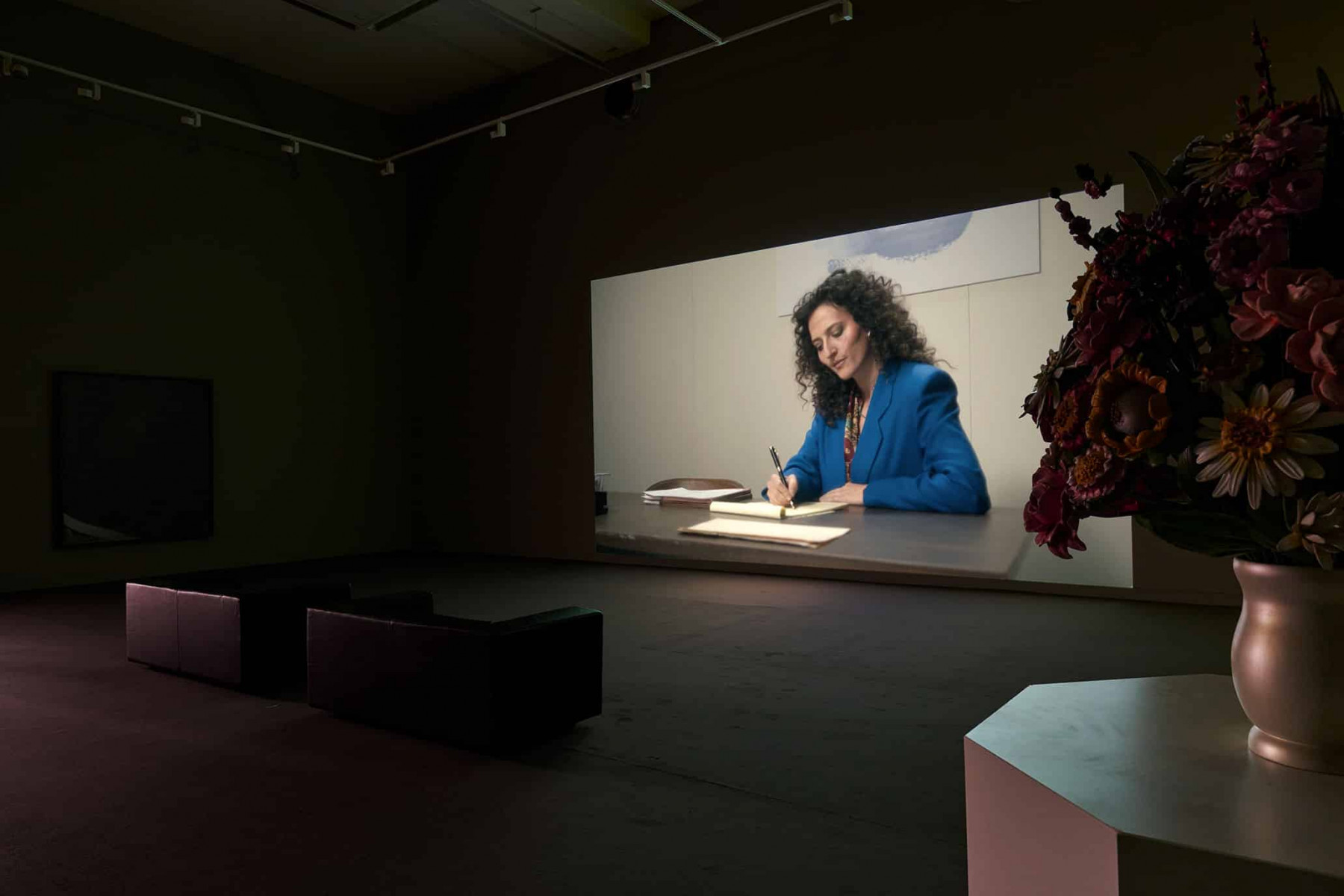Illiberal Lives
Ludwig Forum, Aachen
by Jandra Böttger
imagine i tell you i stepped into a space, and all i could see was furniture. metal stools, wooden stools, giant wooden spoons, cabinets, televisions, glass tables, glasses, plates, mirrors. there was the small purple milka cow my grandma gave to me, there was a big reproduction of the brandenburger tor, very small in comparison to the many wooden cabinets. there also was a parade of tiny men holding glass tables. on these, even smaller fluffy fake flokatis in pastel red and turquoise with rustic baby wooden chairs were placed. you felt like a giant, but standing next to an oversize plaster woman on a badly faked green grass isle, you felt small again. imagine i told you this, it sounds like a dream, right? [1]" and just as we are transformed into things during sleep, so the things in our rooms turn into beings. they are not what we know. (…) they are our things which we resemble and which resemble us, and the deeper we fall into sleep the more we settle into them, or they into us, or all of us together into the room.” [2] the central exhibition space of ludwig forum aachen, around which ten inlets are grouped, is a messy and overcrowded furniture forest – a collective memory cast into wood, carpet, lamps, ceramic ash trays. it is like wandering through someone else’s dreamscape, furnished by the memories of a whole split society.
dreams are of the imagination
the people are of the imagination
light is of the imagination [3]
dreams are of the imagination, sings sandy chamoun in bassem saad’s video work Congress of Idling Persons (2021). the doubled virtuality is touching on impossibility, suggesting that dreams and imagination are of different textures. bassem saad’s works gather in a small isle next to the exhibition center stuffed with furniture as material as mental. i visit that room first and the song wafts through my head like a curatorial subtext. which imagination, i wonder? which dreams? “illiberal lives” seems to be rather about crushed dreams. but the crushing of dreams is also of the imagination. the illiberal imagination is a house built on shards and splitters of lost dreams of freedom.
solitude is of the imagination
fire is of the imagination
masses are of the imagination

Henrike Naumann, Ruinenwert, 2019 / Einstürzende Reichsbauten, 2021, Ausstellungsansicht "Illiberal Lives". Ludwig Forum Aachen, 2023. Photo: Mareike Tocha.
henrike naumann furnishes the dreams of generations, the nightmares and the visions. the political is poured into very personal forms. the furniture preserves these weirdly collective memories of a socialist dictatorship, of a capitalist society that dreams of bourgeois advancement, and of the violent unification of both. it hosts the brutality of what entered the history books as reunification, post-war bourgeois settings, possibilities of right-wing terror, and sell-offs of east german production sites by west german trust companies – standing side by side, united by the massive, excessive, scale-less assembly of furniture, which is the mental furniture we live by and were raised with. the fascist and post-fascist furniture landscape, collected from ebay kleinanzeigen, speaks of more than two social imaginaries in one big bowl of attempted unity. they are “not things but clusters of promise, projection, and speculation that hold up a world that we need to sustain.” [4] the liberal imagination is a house built on capitalist dreams. the illiberal imagination is a house built on their splints.
the single identities of furniture (the couch, the coffee table, the tv, the table, the chairs) are connected to each other by means of a mental infrastructure of living. „ikea is to the art of inhabiting what normative heterosexuality is to the desiring body. a table and a chair form a complementary couple that is not open to question. a wardrobe is a first certificate of private property. a bedside lamp is a marriage of convenience. a sofa facing the TV is a vaginal penetration. the curtain hanging from the window is the anti-pornographic censorship that looms when the night falls.” [5] the couch stores these wishes and visions of new beginnings, of safe homes, of romance and nuclear family life. the tv speaks of after-work hours, beers, and the daily news of reichsbürger and neonazis. the vases linger playfully, resembling uplift dynamics in a well contained wiggle room. the rustic furniture tells stories of a land side idyll, but, as the accompanying text explains, it resembles the view from hitler’s berghof on the obersalzberg. naumann stages scenes in a hotel in chemnitz, but really, history is cut into slices of ideological difference – 1919, 1945, 1992, 1998, 2018 (Evolution Chemnitz, 2020). this archaeology of things in the medium of a hotel (that is in fact also a clothing shop for a right-wing scene) summarizes the ideological shifts, variations and long durée of german fascism, and the efforts of anti-fascist movements tirelessly fighting this slumber party of fascist undercurrents, similarly summarized in a year date.
streets are of the imagination
sadness is of the imagination
the exhibition house, not only this one with its sawtooth roof, is a collector of such dreams, the shattered, the nightmares, the normal, the ancient, the future dreams of the imagination. it collects in different media, in furniture, narrative, tears, soil, paint. the space is guarded by two furies that johanna hedva sent to keep a jealous watch over their work in the north end of the show, and a flying snake, which appears in blaise kirschners work at the south end. those are the figures of protection. remember them, nourish them. let them sit in your mental furniture, make sure they want to stay.
a) the fury of hell carries a torch and the bleeding severed head of a man who certainly did not deserve it any other way. it is the fury advocating for justice against the weight of history, ready to reverse the burden of proof.
b) wamidal is the angry queen of menstruation, sovereignly sorting the dragons in your belly.
c) blaise kirschner’s flying snake carries you to the wholes of history, just to rescue you in their ends.

Johanna Hedva, The Clock Is Always Wrong, 2022, Compendium rarissimum totius, um 1775, Wellcome Collection, Ausstellungsansicht "Illiberal Lives". Ludwig Forum Aachen, 2023. Photo: Mareike Tocha.
injustice is of the imagination
sounds are of the imagination
solitude is of the imagination
blaise kirschner’s paintings are gentle, but also precise, geometric. a film accompanies them, revealing the working process. while tracing forms, kirschner talks about some kind of monster she dreamed of. about a woman who was so angry that they wanted to render her harmless by taking out her brain and cutting off her tongue. but she does not weaken. this infinitely beautiful creature, as she describes it, just continues to make plans without a brain. she speaks without a tongue, and i imagine the sounds like a mad unleashing. the story tells itself as if the brain was previously constrained in thinking, and the tongue hindererd in speaking by its own materiality. now the thinking and speaking is boundless, without bodily bases. without the laws inscribed as “somatic fictions”, [6] without the rituals of patriarchal thinking that we repeat daily, unless we actively and with the greatest effort decide against them again and again. this antimaterialist fable has its morale: if mental infrastructure is, what is engrained in our body by numerous repetitions, how beautiful must letting go feel? blaise kirschner cannot get rid of her scorn. “i feel like i'm only alive because i'm so angry,” the protagonist of the film says to her daughter. “i paint organs all the time, hands, intestines, severed intestines, and i'm just so angry.” the video works of johanna hedva and blaise kirschner, together with their furies, mark a diagonal bracing of rage through the exhibiton space. the invisible line connects the utmost parts of the exhibition.

Blaise Kirschner, UNICA, 2022, Videostill, Animation: Diana Gradinaru. Copyright: Blaise Kirschner, Ausstellungsansicht "Illiberal Lives". Ludwig Forum Aachen, 2023. Photo: Mareike Tocha.
doom is of the imagination
tears are of the imagination
silence is of the imagination
while bassem saad’s video-work explores a semi-fictional semi-surrealist, also dream-like aesthetic, re-staging accounts of how the protagonists experienced the lebanon uprisings in beirut, in 2019, scorn is to be found here, too. it is a desperate, powerless scorn. “i haven’t slept for three days and you are making your sessions here!”, re-narrates one protagonist in a scene in a quiet, matter of factly way, where a protester from the street crashes something like a teach-in on lebanon’s economic possibilities as oil producing country. the surreal atmosphere of conversations is disrupted by street style reportages on black lives matter demonstrations. these are different dreams of the imagination. they are of illiberal texture. it is the big brands’ neon lights, adidas, monuments, and some work-out game. but then, the dreams of freedom smash the dreams of illiberalism. they throw stones, freedom against freedom, one concept against the other, but one is materialist, one is about survival and emancipation, while the other is about profit. both dreams are of different imaginations, both imaginations of different dreams, dreams and imaginations of different textures.
the woman disturbing the lecture on lebanon’s economy is called hysteric in the protagonist’s narrative. a black migrant person was excluded because the fight was for ‘the lebanese only’ and her skin was not light enough to pass. another protagonist recounts a situation of women being harassed at demonstrations. “they protest against sexual violence, but look at them. they are not even worth to be sexually harassed.. the fury of hell carries a torch and the bleeding severed head of a man who certainly did not deserve it any other way. the mental furniture that is made to break your back, the electric chair of the torture chamber furniture ware house. it is always there, every room has it, every school has it, every revolution. because dreams are made of the imagination – and the imagination is always a big reservoir of past indignities, the collected waters that went down the river of misogyny, sexism, and gendered violence. a manual for post-revolutionary analysis. the usual shattered dreams of the revolution, woven into a thick texture of sounds and image.
bassem saad confronts the image material from lebanon with black lives matter, showing the ambivalences of a protest, the messiness, the discrimination inside a movement, the different capacities and needs. if the social imaginary is a passive repertoire of violence, of trauma, imagination is also about fantasy, about creation of something else. fantasy as an elastic imaginative superpower that “points to and protects ambivalence without erasing it.” [7] fantasy is part of our mental infrastructure that is able to create freshly, yet it is always bound to the existing mental infrastructures, and also the material ones. infrastructure is the constant organizing for a revolution, but infrastructure is also the oil storage hall that exploded in beirut’s haven. “goods, buildings, and roads are infrastructures embedded in the flow of history, appearing as embodiments of objective historical forces that cannot be experienced directly, connecting with our ‘unconscious’ and thus with the collective imagination, giving them the potential to mobilize feelings, emotions, and desires.” [8] infrastructures are the most tiresome part of our reality, because they never just exist. they always are being and have to be repeated, re-iterated, re-elaborated, trotted down, fought for. the slightest shift in thinking is based on decades of infrastructural work. because we do not live in the neo-materialist work of unleashed scorn and power that blaise kirschner dreams of, in its own monstrous ways.
existence is of the imagination
absence is of the imagination
the invisible is of the imagination
tired, i am sinking into a very squashy double-seat leather sofa like corbusiers lc3, in a very dark high ceiling room. jeff koons large vase of flowers (1991) and domenico gnoli’s wrist watch (1969) make me numb. kerstin stakemeier describes domenico gnoli's painting of an oversized jacket sleeve with cufflinks and a watch as “overwhelming the viewer with material trivia,” and the overall combo as a “style that has aged badly.” [9] the leathern cozy two-seater is not mentioned in the accompanying booklet. as furniture, it is apparently not part of the artist’s selection. and yet it is the bridge to reality. jordan strafer exhibits a reality, and exhibits me along with it. what seems neutral, or pragmatic, is a sign of a bourgeois standard. the leathern two-seater in front of the video work is a solid blowjob, i could say with preciado. it is a very basic tool in any standard repertoire of male oriented sexual mental furniture, bound to power play, hierarchies and domination.

Jordan Strafer, LOOPHOLE, 2023, Illiberal Lives, Ausstellungsansicht, Ludwig Forum Aachen, 2023, Foto: Mareike Tocha
it is insignia of power that jordan strafer’s video work loophole (2023) embarrasses: they are too big to fail, just like the kennedy family who is obviously winning the trial against patricia bowman as restaged in strafer’s video. “whatever the outcome of the process, it will be a good one for us”, kennedy’s elite advocate states overconfidently. we follow the prosecutor proceeding on his own infrastructures that are mental, and material, but most importantly institutional. he does not need furniture, because he is standing. he only needs furniture to fixate those around him. his agility is power in a courtroom, where furniture is as massive as the history of law, and screwed to the grounds, connected to each other, making it a whole landscape of seats and positions. we follow him through a mental architecture of the rape setting. a house, a garden, a beach, a staircase. the materialities around us are of his imagination: the re-traumatizing imaginary walk through the crime scene, the flyspecked recalling of its architecture as if the victim was its architect, as if some of the two women, one victim, one witness, planned the staircase, drew the floor plan, furnished this nightmare.
while both parties, the pro-kennedys, as well as the pro-smiths, have the right to utter their opinion, some are trained to harass, to twist the truth, and to appropriate reality by any means; others are overawed by the atmosphere of the court, masculine rhetorics, as well as the truth or rape itself. „they had no technique; it was really just the truth“, someone in the film says. strafer’s work shows how the truth is chewing gum, twisted, stretched, ever evolving, until it is eventually sucked dry and can be thrown away entirely. the taste of truth remains where there was evidence before. evidence is a pair of trousers that everybody in court touches – another, now object-based iteration of the rape, of intimacy being turned public against your consent.
this is a school of saying yes that went down history as deductive procedure based on logic linguistic. the advocate walks you “in fine-grained, blow-by-blow detail through the microculture of linguistic practice and male hegemony.” [10] it is the brutality of a rhetoric repetition of rape, yes, yes, yes. maybe, maybe, no. it is the forced yes against all truth and knowledge about truth, it is a yes that is the opposite of affirmation. the witness is forced to affirm the twisted reality of the advocate. the mental highways of yes are on full speed and no exit, or turn, available. the maybes and nos are dirt tracks through a mined field. the memory of where the mines are to be found is part of a dreamlike subconscious that is older than history. the fury of hell carries a torch and the bleeding severed head of a man who certainly did not deserve it any other way. [11] when is time for revenge?
the bullet is of the imagination
blood is of the imagination
betrayal is of the imagination
“i don’t know how to separate my politics from my scorn.”, says the room’s reality voice over in yet another decentralized exhibition bay. the time of revenge, of anger, is always wrong. it is never accurate, never on point. the mystical time johanna hedva and leonie ohlow bring into operation, however, is right. it is on time. every day, exactly when the sun reaches its highest point, a spoon full of black pigment drops on a white paper. the movement of the spoon slowly transporting the pigment is too slow to see big differences. every object in this room is a time keeping piece, yet every installation registers its own timing.
“time is an infrastructure because it is a condition of possibility for conscious perception and action; infrastructure is made out of time insofar as infrastructure is that which repeats. the repetition is normalized into everyday routine.“ [12] this way time becomes a mental infrastructure, the clock a mental furniture, as every object’s presence can become a clock. They comment on shifts in temporalities, the reality voice-over says about the installed time-practicing entities, in their beautiful descriptive, informative, narrative, loving and scorning tone. there is the time of revenge that is always ready (the fury of hell carries a torch and the bleeding severed head of a man who certainly did not deserve it any other way) and there is the time of mourning that is always too late (the voice tells that moths where inhabiting the artist’s trauerhaus for three years after their mom’s passing and that according to a korean tradition, a ghost, especially one lined with scorn and sadness, needs three years “to polish itself”), and there is the time of anger, that is simultaneous (if you throw words in scorn, they all come at the same time. you don’t know which hits the right spot, and only if you are lucky you will get to know about it afterwards). johanna hedva’s knives stick to the wall, as if thrown all at the same time. And while the hanging looks cruel, what actually is being hanged by the knives seems to be the sweetest, absurdest conversation through time zones by mail with a witch in poland.
desire is of the imagination
we were talking about liberal dreams stuffed with illiberal furniture. the illiberal dream is made of scorn, power and revenge. our brains’ worlds are furnished with knives and leather couches. martial illiberal arts. we need the mental machetes for cutting our way towards new desire paths. someone else was here before. the fury of hell is of the imagination, but so is wamidal and blaise kirschner’s flying snake. they have their mental infrastructures, but we have our dream furniture, real dreams of “organized air, the projected atmospheres sustained by collective practice.” [13]
the dreams of the imagination, they flocked
~~manifesting~~
[1] These listed items are part of Henrike Naumann’s installations Das Reich (2017), including Jörg Immendorf’s Naht (Brandenburger Tor – Weltfrage), 1982-83; and Ruinenwert (2019) / Einstürzende Reichsbauten (2021), including Alexander Rukaschnikows‘ Sommer in der Stadt (1972).
[2] El-Wardany, Haytham. The Book of Sleep. Kolkata: Seagull Books, 2021
[3] alle lines die dieser art kursiv in den text gesetzt sind entstammen dem song Dreams Of The Imagination احلام الخيال von sandy chamoun aus bassem saads videoarbeit Congress of Idling Persons (2021). URL: https://soundcloud.com/user1767824. You can listen to this 07 min 05 sec song while reading this text.
[4] Berlant, Lauren. On the Inconvenience of Other People, Durham and London: Duke University Press, 2022, p. 27.
[5] Preciado, Paul B. My Trans Body Is an Empty House. In An Apartment on Uranus. Chronicles of Crossing. South Pasadena: Semiotext(e), p. 186.
[6] “These are somatic fictions, not because they lack material reality but because their existence depends on what Judith Butler calls the performative repetition of processes of political construction.” Preciado, Paul (Beatriz), Testo Junkie. Sex, Drugs, and Biopolitics in the Pharmacopornographic Era. New York: The feminist press at the City University of New York, 2013, p. 69. Paul B. Preciado builds on Butler, Judith: Gender Trouble: Feminism and the Subversion of Identity (New York: Routledge, 1990).
[7] Berlant, Lauren. On the Inconvenience of Other People, Durham and London: Duke University Press, 2022, p. 26.
[8] Buchmann, Sabeth: “Finite Repetitions” In: Beck, Martin; von Bismarck, Beatrice; Buchmann, Sabeth; und Lafer, Ilse: Broken Relations. Infrastructure, Aesthetics, Critique. Leipzig: Spector Books, 2023. Sabeth Buchmann expands on Brian Larkin’s Text „Promising Forms: The Political Aesthetic of Infrastructure”, in Nikhil Anand, Akhil Gupta, Hannah Appel, eds.: The Promise of Infrastructure. Durham: Duke Universtiy Press, 2018, p. 328.
[9] Kerstin Stakemeier schreibt über Jordan Strafer’s Arbeit Loophole (2022), siehe Begleitheft zur Ausstellung „Illiberal Lives“: https://ludwigforum.de/wp-content/uploads/2023/05/Booklet_Illiberal_Lives_DE_EN_LFA_2023.pdf
[10] Matoesian, Gregory M.: "You Were Interested in Him as a Person?": Rhythms of Domination in the Kennedy Smith Rape Trial, In: Law & Social Inquiry , Vol. 22, No. 1 (Winter, 1997), pp. 55-93.
[11] Johanna Hedva, The Clock Is Always Wrong, 2023
[12] Vishmidt, Marina: Between Not Everything and Not Nothing: Cuts Towards Infrastructural Critique, in The Former West: Art and the Contemporary after 1989, eds. Maria Hlavajova and Simon Sheik (Cambridge, MA: MIT Press, 2017), 265–268: 265., p. 265.
[13] Berlant, Lauren. On the Inconvenience of Other People, Durham and London: Duke University Press, 2022, p. 23.
Illiberal Lives
22.04.2023 – 10.09.2023
Participating artists:
Pauline Curnier Jardin, Johanna Hedva, Ho Rui An, Blaise Kirschner, Jota Mombaça, Henrike Naumann, Melika Ngombe Kolongo, Bassem Saad, Mikołaj Sobczak, and Jordan Strafer and, selected by the artists, a rehanging of works from the collections at the Ludwig Forum Aachen of Vincent Desiderio, Jann Haworth, Domenico Gnoli, Renato Guttuso, Jörg Immendorff, Magdalena Jetelová, Lev Kerbel, Konrad Klapheck, Jeff Koons, Thomas Lanigan-Schmidt, Lee Lorzano, Wolfgang Mattheuer, Klaus Paier, Tõnis Vint, and Andy Warhol
Curated by Eva Birkenstock, Anselm Franke, Holger Otten and Kerstin Stakemeier
Ludwig Forum Aachen
Jülicher Straße 97–109
52070 Aachen